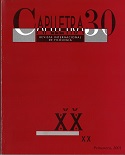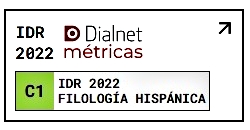Els derivats d'«esse» i «stare» en les llengües romàniques
DOI:
https://doi.org/10.7203/caplletra.30.4961Palabras clave:
verb llatí «esse», verb llatí «stare», llengües romàniques, anàlisi contrastiva, Resumen
Resumen
This paper presenta a contrastive analysis of the Romance verbs derived from ESSE and STARE. The lexical and syntactic
characteristics of these verbs in Latin and their locative and atributive uses clearly contrast with actual Romance uses. This contrast
highlights the variable extension of the verbs derived from STARE assuming the space of those derived from ESSE.One extreme of the
clyne is represented by the Hispanic languages (i.e., Spanish, Portuguese and Catalan), which have developed more uses and thus
extended further the STARE forms. On the opposite extreme, there is French, which has no STARE uses. In between, there are Occitan,
Sardinian, Italian and Romanian, which include some forms derived from STARE, but their extension is inferior to the extension reached in the Hispanic languages. The analysis focusses on the factors that have interacted and influenced on this extension of use and points to the present tendencies.
 Descargas
Descargas
Descargas
Publicado
Cómo citar
-
Resumen530
-
PDF (Català)296
Número
Sección
Licencia
El autor o autora que dirija un trabajo a la redacción de Caplletra para ser publicado tiene que ser la persona titular legítima de los derechos de explotación. La legitimación para la publicación del trabajo tiene que incluir también las imágenes, las tablas, los gráficos y otros materiales que puedan complementar el texto, con independencia de si es su autor o autora.
Copyright. Al publicar el trabajo en la revista, el autor o autora cede a Caplletra. Revista Internacional de Filologia los derechos de explotación (reproducción, distribución y comunicación pública), tanto para la edición impresa en papel como para la versión electrónica.
Todos los trabajos publicados en Caplletra se encuentran bajo una licencia Creative Commons del tipo Reconocimiento-NoComercial-SinObraDerivada 4.0.
RESPONSABILIDAD
Caplletra. Revista Internacional de Filologia no se identifica necesariamente con los puntos de vista sostenidos en los trabajos que publica.Caplletra. Revista Internacional de Filologia declina toda responsabilidad derivada de cualquier vulneración eventual de los derechos de propiedad intelectual que pudiera ser llevada a cabo por los autores o autoras.






